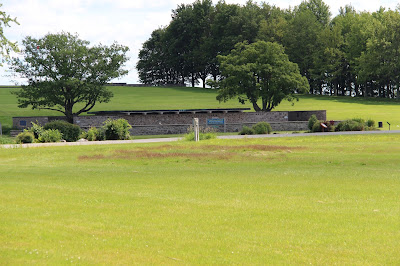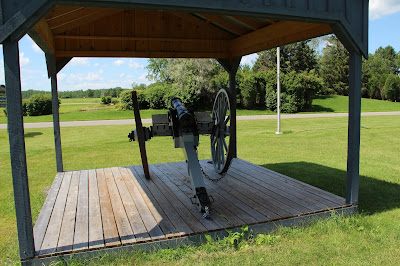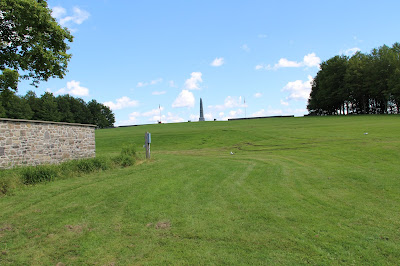The Battle of Crysler's Farm did not happen on the memorial site. The battle took place at a location west of the memorial site that is now under water due to the St. Lawrence Seaway project, completed in 1959. The mound on which the Battle of Crysler's Farm monument stands was built using earth taken from the site of the battle.
 |
| PARKS OF THE ST. LAWRENCE |
Just to give you an idea of its size, the battle's memorial site, not including adjacent land that could be considered part of it, measures about 3/4 of a kilometer (.46 mile) long by 185 meters (608 ft.) wide (13.8 hectares/34.25 acres).
QUEEN ELIZABETH GARDENS
THE POND & THE FOUNTAIN
Through history fountains have been placed to celebrate and symbolize achievement and to commemorate great events. This fountain, with the pond and surrounding flower banks was created to commemorate the visit of Queen Elizabeth II to Ontario in 1984 by the Province on behalf of the people of Ontario.
North of the pond is a wetland area, with wildflowers and wetland shrubs, some from seeds collected locally.
(I looked around there but did not see a fountain.)
LE JARDIN REINE ÉLIZABETH
L'ÉTANG ET LA FONTAINE
D'âge en âge des fontaines ont été édifiées pour célébrer et symboliser les réalisations des hommes et commémorer les grands événements. Cette fontaine, l'étang et les talus de fleurs adjacents ont été érigés au nom des citoyens de l'Ontario par le gouvernement de la province pour commémorer la visite de la reine Élizabeth II en Ontario, en 1984.
Au nord de l'étang s'étend une zone marécageuse jonchée de fleurs sauvages et d'arbustes dont certains proviennent de graines recueillies dans la région.
(J'ai regardé autour de là mais je n'ai pas vu une fontaine.)
BATTLE OF CRYSLER'S FARM 1813
In November, 1813, and American army of some 8000 men, commanded by Major-General Wilkinson, moved down the St. Lawrence en route to Montreal. Wilkinson was followed and harassed by a British "corps of observation" consisting of about 800 regulars, militia and Indians commanded by Lieut.-Col. Joseph Morrison. On November 11, Morrison's force, established in a defensive position on John Crysler's farm, was attacked by a contingent of the American army numbering about 4000 men commanded by Brigadier-General J. P. Boyd. The hard fought engagement ended with the Americans' withdrawal from the battlefield. This reverse, combined with the defeat of another invading army at Chateauguay on October 26, saved Canada from conquest in 1813.
Archaeological and Historic Sites Board of Ontario
War of 1812 Light 6 Pounder Gun
This is a replica of a typical 6 pounder (2.7 kg) muzzle loading gun (guns were measured by the weight of the solid shot they fired) as used both by British and US Artillery in the War of 1812 at the Battle of Crysler's Farm. Made out of cast iron, bronze wa also used extensively by both sides for guns of this size. Bore size is 3.66 inches (9.3 cm). It had a range of 1200 yards (1097 m) with solid shot and 300 yards (274 m) with grape or canister shot with a firing rate of 2 or 3 rounds a minute. It was drawn by 4 or 6 horses hitched to a 2 wheeled limber which doubled as a munitions wagon. A gun crew consisted of up to 15 men plus horse riders and handlers.
This gun was made possible in part by a donation from the Friends of the Crysler's Farm Battlefield and a grant from Heritage Canada in 2013 in recognition of the 200th Anniversary of the Battle of Crysler's Farm that took place on November 11, 1813 on the Casselman, Loucks, Fetterly, Atkinson, Haines and Boucks farms.
 |
| BRITISH COURT OF HONOUR |
The St. Lawrence Parks Commission gratefully acknowledges the outstanding contribution of the Friends of Crysler's Farm Battlefield to the preservation and promotion of the nationally significant military engagement fought on November 11, 1813 in a muddy farmer's field beside the St. Lawrence River. The Battle of Crysler's Farm marked the end of the most serious American attempt to conquer Canada during the War of 1812.
With the help of the Friends, the Battlefield Memorial Building was re-opened in 1999. A dedicated group of volunteers, the Friends have created renewed interest in the battle and its presentation to the Canadian people. It is thanks to their vision and successful fundraising efforts that the building is staffed, maintained, and open to the public during the main tourism season.
Since 2000, the Friends have been instrumental in sponsoring the yearly Military Re-enactment Weekend which has become Eastern Ontario's foremost living history event, and which attracts hundreds of re-enactors and thousands of visitors to the site.
The group's aim is to continue its partnership with the St. Lawrence Parks Commission towards a common goal of rejuvinating the Battlefield Memorial Building, the Memorial mound and the surrounding grounds.
This plaque was presented to the Friends on November 11, 2005 in recognition of their untiring commitement to raise awareness of the Battle of Crysler's Farm and the vital role it played in the history of Canada.
La Commission des parcs du Saint-Laurent reconnaît avec gratitude la contribution remaquable des Amis du champ de bataille de la ferme Crysler pour la préservation et la promotion de l'affrontement militaire d'importance nationale combattu le 11 novembre 1813 dans un champ boueux à côté de fleuve Saint-Laurent. La bataille de la ferme Crysler a marqué la fin de la plus sérieuse tentative américaine de conquérir le Canada pendant la guerre de 1812.
L'édifice commémoratif du champ de bataille a été ouvert de nouveau 1999 avec l'aide des Amis, un groupe de bénévoles dévoués, ont créé un intérêt renouvelé dans la bataille et sa présentation au peuple canadien. C'est grâce à leur vision et à leurs efforts de collecte de fonds que l'édifice est pourvu de personnel, entretendu, et ouvert au public pendant la principale saison touristique.
Depuis 2000, les Amis ont contribué à parrainer la fin de semaine de reconstitution militaire annuelle qui est devenue l'un des principaux événements d'histoire vivante de l'est de l'Ontario et attire des centaines d'interprètes militaires historiques et des milliers de visiteurs au site.
Le but de groupe est de continuer son partenariat avec la Commission des parcs du Saint-Laurent vers un but commun de rajeunir l'édifice commémoratif du champ de bataille, la colline commémorative et les terrains qui les entourent.
Cette plaque a été présentée aux Amis le 11 novembre 2005 en reconnaissance de leur inlassable dévouement à accroître la sensibilisation à la bataille de la ferme Crysler et le rôle vital qu'elle a joué dans l'histoire du Canada.
 |
| Interactive diorama of the Battle of Crysler's Farm |
 |
| CANADIAN COURT OF HONOUR |
 |
| IN HONOUR OF THE BRAVE MEN WHO FOUGHT AND FELL IN THE VICTORY OF CRYSLER'S FARM ON THE 11TH NOVEMBER 1813 THIS MONUMENT WAS ERECTED BY THE CANADIAN PARLIAMENT 1895 |
BATTLE OF CRYSLER'S FARM
Here, on the farm of John Crysler, was fought one of the decisive battles of the War of 1812. On 11 November 1813 Lieutenant-Colonel Joseph Morrison, with 800 British and Canadian regulars, militia, and Indians, engaged an American force of 4,000 under Brigadier-General John Boyd. The open terrain was suited to the training of the well-drilled British regulars who, after two hours of heavy fighting, routed the enemy. This victory ended a major American thrust at Montreal.
Historic Sites and Monuments Board of Canada.
Government of Canada - 1923
BATAILLE DE LA FERME CRYSLER
Ici fut livrée des batailles décisives de la guerre de 1812. Le lieutenant-colonel Joseph Morrison, à la tête de 800 hommes (réguliers britanniques et canadiens, miliciens et Indiens) livrait combat, le 11 novembre 1813, aux 4000 homes du brigadier-général américain John Boyd. Les réguliers britannique, bien exercés au combat en rase campagne, mirent les Américains en fuite après deux heurs de rude bataille. Cette victoire brisa la poussée important de l'ennemi vers Montréal.
Commission des lieux et monuments historiques du Canada.
Gouvernement du Canada - 1923














































































































